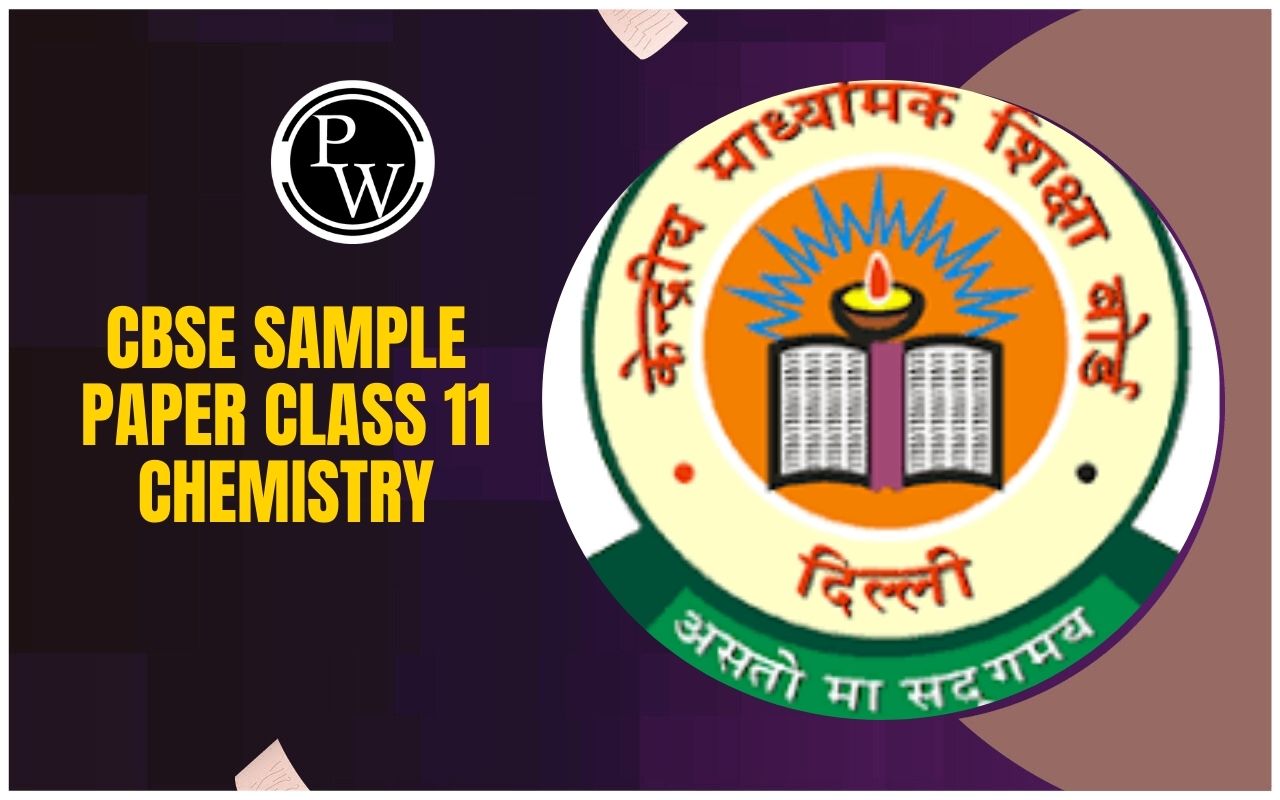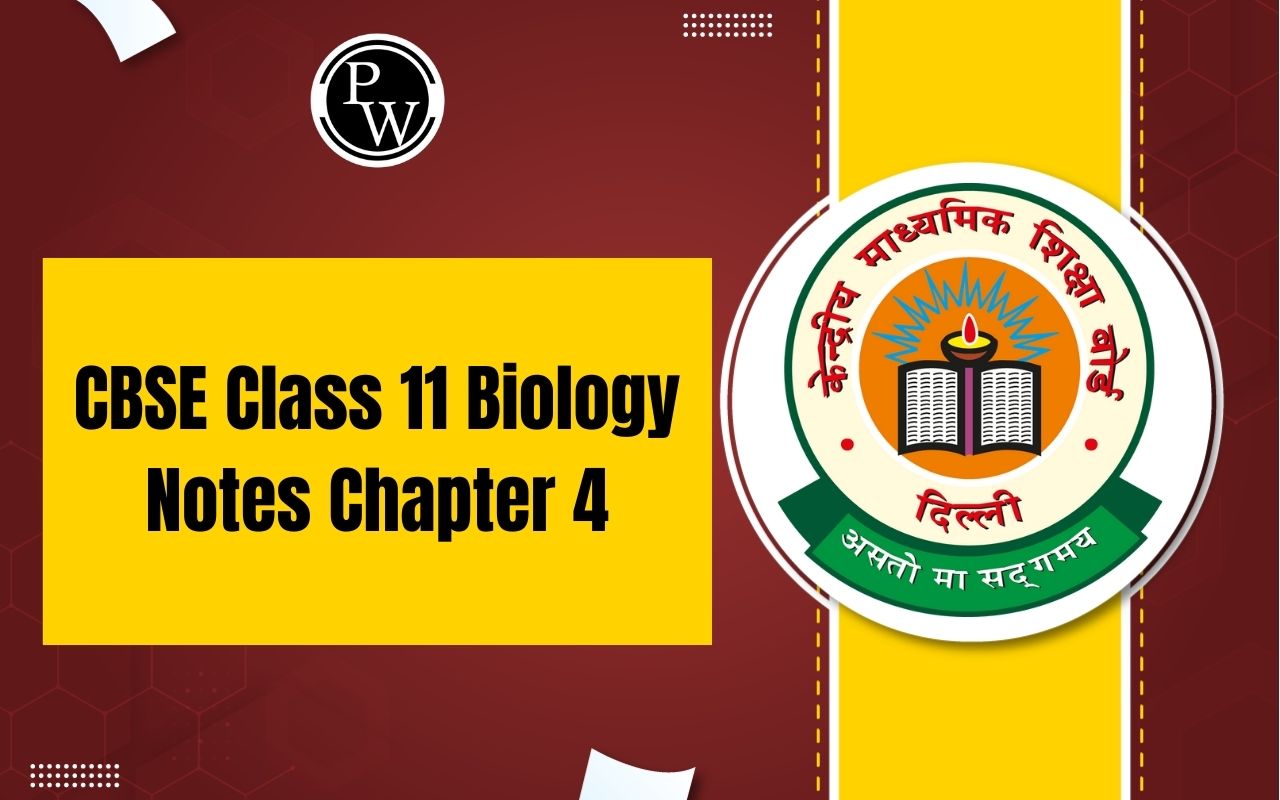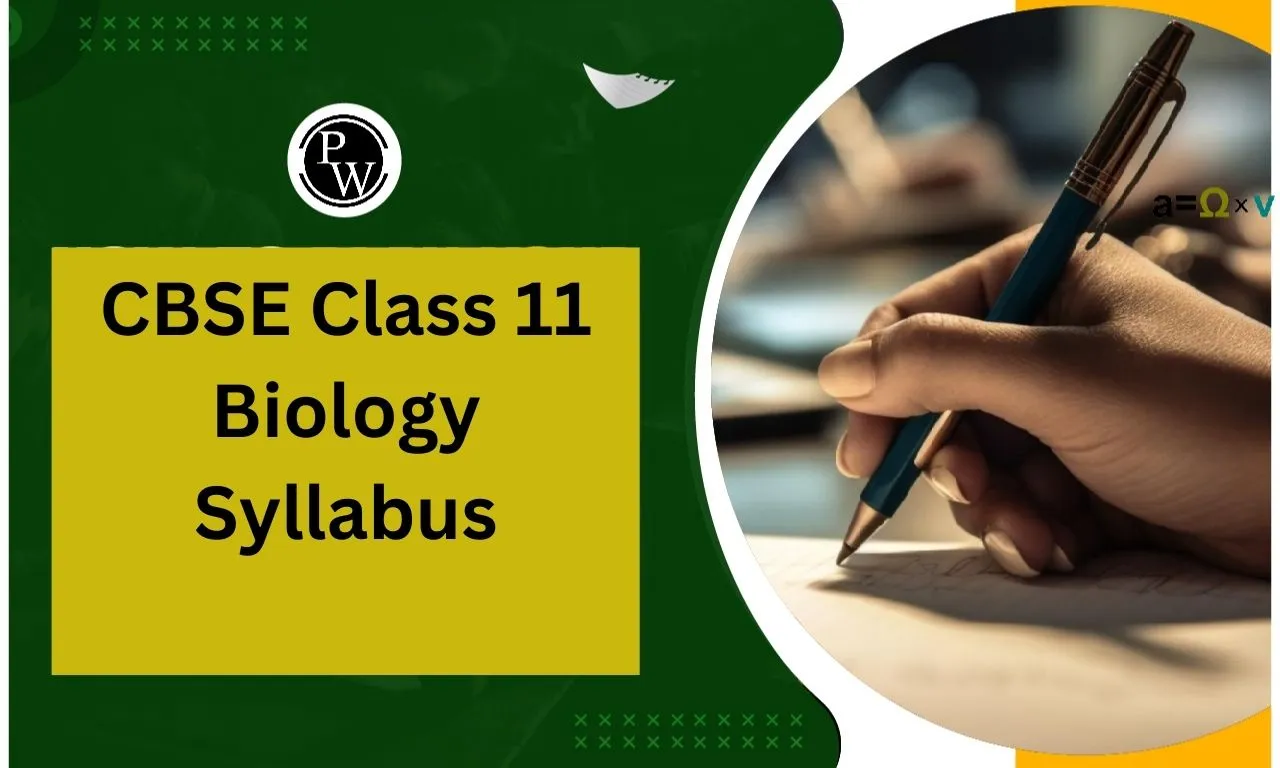
class 11 biology chapter 5 notes: In CBSE Class 11 Biology Notes Chapter 5, we learn about the Morphology of Flowering Plants. This means we study how different parts of plants look and work. We explore things like roots, stems, leaves, flowers, and fruits. We find out how these parts help plants grow, reproduce, and survive. The chapter also talks about different kinds of flowers and how they are classified.
By understanding this, we can identify and know more about various plant species. With easy explanations and pictures, this chapter helps us appreciate the amazing world of plants in a simple and clear way.CBSE Class 11 Biology Notes Chapter 5 Morphology of Flowering Plants PDF
Our subject experts has created detailed notes for CBSE Class 11 Biology Notes focusing on Chapter 5: Morphology of Flowering Plants. This PDF provide detailed explanations of the structure and form of flowering plants, covering essential topics such as root, stem, leaf, flower, and fruit morphology.With clear explanations and illustrative diagrams, students will gain a deep understanding of the anatomical features that characterize different plant species. Whether you're studying for exams or simply seeking a better grasp of plant biology, this resource is an invaluable resource for enhancing your knowledge.
CBSE Class 11 Biology Notes Chapter 5 PDF
CBSE Chapter 5 Biology Class 11 Notes
Morphology of Flowering Plants
class 11 biology chapter 5 notes The morphology of flowering plants refers to the study of their external structure and form. This branch of botany delves into the diverse features of plants, including roots, stems, leaves, flowers, and fruits. By examining these components, botanists gain insight into the adaptation, growth, and reproductive strategies of flowering plants.Morphological studies often involve the observation and analysis of plant organs, their arrangement, and their functions, contributing to our understanding of plant diversity and evolution. Overall, the study of morphology is essential for comprehending the biology and ecology of flowering plants.
The Root
The root is a important part of a plant's anatomy, serving several essential functions. Primarily, roots anchor the plant in the soil, providing stability and support. They also absorb water and nutrients from the soil, which are necessary for the plant's growth and development. Roots store reserve food materials such as starch, which can be utilized during times of need. Roots come in various types, including the taproot, fibrous root, and adventitious root.- Taproots , found in dicotyledonous plants like gram and mustard, have a primary root that elongates from the radicle and gives rise to secondary and tertiary roots.
- Fibrous roots , typical of monocotyledonous plants such as rice and wheat, form a dense network originating from the base of the stem.
- Adventitious roots , unlike taproots, develop from various parts of the plant other than the radicle. Examples include grass, banyan trees, and maize.
Modification of the Root
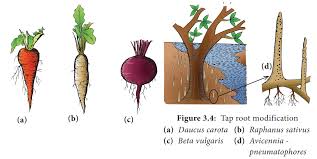
Storage: Taproots like carrots and turnips, as well as adventitious roots like those of sweet potatoes, store nutrients to support the plant's growth and survival.
Support: Some roots provide additional support to plants. For example, the prop roots of banyan trees emerge from branches, while the stilt roots of maize and sugarcane arise from lower stem nodes, aiding in anchorage and stability.
Aeration: In environments with low oxygen levels, certain roots facilitate respiration. Pneumatophores, such as those found in mangroves like Rhizophora, grow upwards above the ground to access oxygen.
Nitrogen Fixation: Root nodules in leguminous plants harbor nitrogen-fixing bacteria, allowing the plant to convert atmospheric nitrogen into a usable form for growth.
Stems
The stem develops from the plumule during plant growth. It consists of nodes, where leaves are attached, and internodes, the segments between nodes. Stems support the plant's leaves and facilitate the transport of water, nutrients, and other essential substances throughout the plant.Modification of the Stem
Stems undergo various modifications to serve specific functions in plants: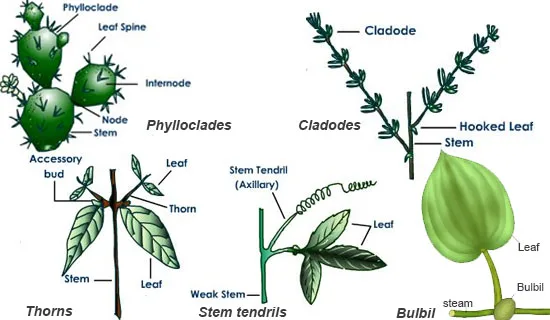
Underground Stem:
- Rhizome: Runs parallel to the ground with nodes, internodes, and buds (e.g., ginger, banana).
- Tubers: Swollen end part underground for nutrient storage (e.g., potato).
- Corm: Grows vertically below ground (e.g., colocasia).
- Bulb: Reduced stem surrounded by scaly leaves (e.g., garlic, onions).
Stem Tendrils: Coiled structures supporting tender stems for climbing (e.g., grapes, cucumber, pumpkin).
Thorn: Modified axillary buds forming pointed thorns for protection against grazing animals (e.g., Bougainvillea, citrus).
Subaerial Weak Stem:
- Offsets: Lateral branches with reduced internodes, forming a rosette of leaves (e.g., Eichhornia, Pistia).
- Suckers: Lateral branches from the underground stem (e.g., chrysanthemum, banana, pineapple).
- Runners: Horizontal stems above ground with roots at nodes (e.g., grasses, strawberry).
- Stolon: Lateral branches initially growing laterally, then bending down to produce new daughter plants (e.g., mint).
Aerial Modification: Complete transformation of the stem for specific adaptations.
- Phylloclade: Fleshy, green stem with photosynthetic pigments, serving as leaves to reduce water loss (e.g., Euphorbia, Opuntia).
The Leaf
The leaf is a fundamental part of a plant's anatomy, responsible for essential functions such as photosynthesis, gas exchange, and transpiration. Its structure is optimized to maximize these processes efficiently.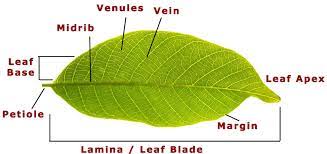 A leaf consists of several main parts:
A leaf consists of several main parts:
Blade or Lamina: The broad, flat part of the leaf where most photosynthesis occurs.
Petiole: The stalk that attaches the leaf to the stem, allowing it to position itself for optimal sunlight exposure.
Veins: Vascular bundles that transport water, nutrients, and sugars throughout the leaf.
Midrib: The central vein running through the center of the leaf.
Margin: The edge of the leaf, which may be smooth, serrated, or lobed depending on the species.
Stipules: Small, leaf-like structures found at the base of the petiole in some plants.
Modification of Leaves
Leaves undergo various modifications to fulfill specialized functions in plants:Tendrils: Leaves modified into long, thread-like structures that provide support to climbing plants, such as peas.
Spines: Modified leaves found in xerophytic plants, like cacti and aloe, serving to reduce water loss by minimizing surface area and deterring herbivores.
Storage: Leaves adapted for storing nutrients or water, as seen in garlic and onions.
Phyllodes: Petioles modified into leaf-like structures that perform photosynthesis, as observed in Acacia plants.
Pitchers: Modified leaves in pitcher plants, forming a pitcher-shaped structure that traps and digests insects for nutrients.
Inflorescence
Inflorescence refers to the arrangement of flowers around the floral axis, and there are two main types:Racemose: In racemose inflorescence, the main axis grows indefinitely, and flowers are arranged laterally in acropetal succession, meaning older flowers are located at the bottom, and younger ones at the top. Examples of racemose inflorescence include raceme, spike, umbel, capitulum, corymb, catkin, and spadix.
Cymose: Cymose inflorescence occurs when the main axis terminates in a flower and has limited growth. Flowers are borne in a basipetal order, with older flowers at the top and newer ones at the bottom. Types of cymose inflorescence include monochasial cyme and dichasial cyme.
There are special types of inflorescence:- Verticillaster: Sessile flowers arranged in dichasial cymes, seen in plants like Ocimum and Salvia.
- Cyathium: Involucre of bracts forms a cup-shaped structure, with a single female flower surrounded by numerous male flowers, as found in Euphorbia.
- Hypanthodium: Both male and female flowers are present in a cavity with an apical opening called ostiole, seen in plants like the fig tree.
The Flower
A flower consists of four whorls: calyx, corolla, androecium, and gynoecium, all attached to the swollen terminal of the pedicel called the thalamus. Flower symmetry can be categorized into two main types:- Actinomorphic: These are radially symmetrical flowers, meaning they can be divided into equal parts in multiple vertical planes. Examples include chilli, datura, and mustard.
- Zygomorphic: These flowers can be divided into two equal parts in only one vertical plane. Examples include Cassia, pea, etc.
- Hypogynous: The gynoecium occupies the highest place, above all other parts, and the ovary is known as superior. Examples include brinjal, China rose, and mustard.
- Perigynous: The gynoecium is at the same level as the other parts of the flower, and the ovary is termed as half inferior. Examples include peach, plum, and rose.
- Epigynous: The thalamus encloses the ovary completely, and other parts are present above it. The ovary is known as inferior. Examples include the ray florets of a sunflower, guava, and cucumber.
Parts of a Flower
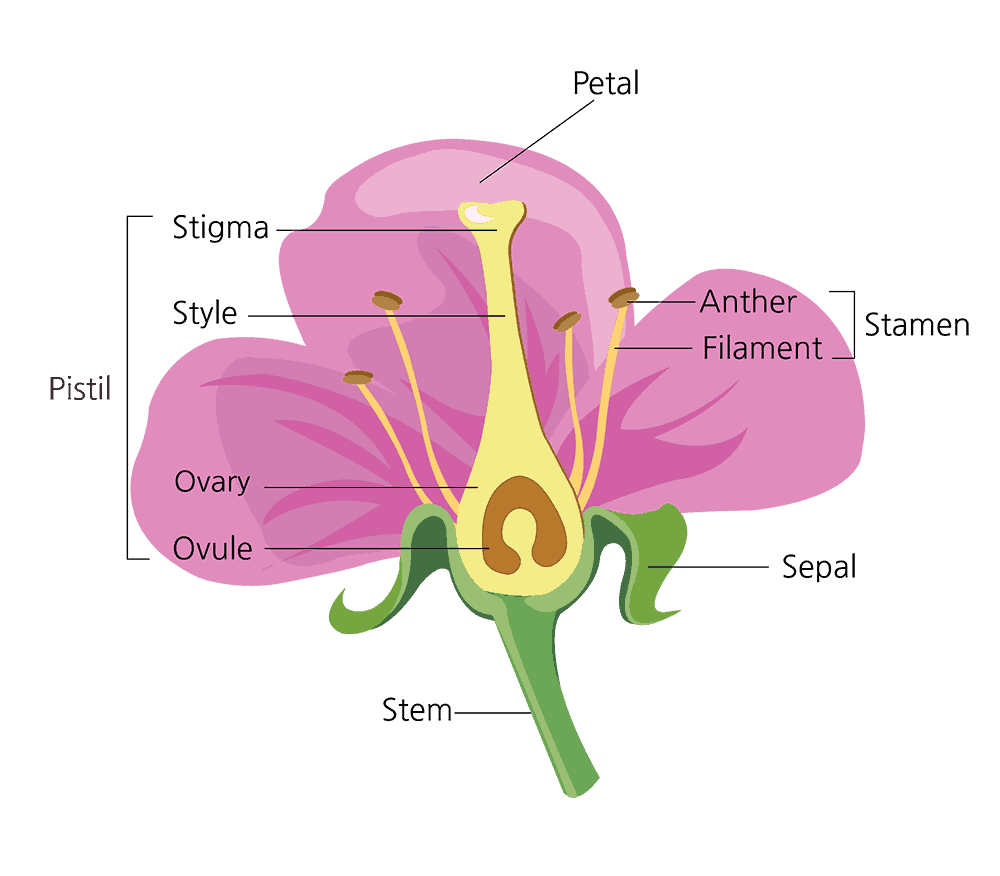
Calyx: The outermost whorl of a flower consists of leaf-like structures known as sepals. These sepals may exhibit two main types of arrangements:
- Gamosepalous: Sepals are fused or united together.
- Polysepalous: Sepals are free or not fused.
Corolla: Following the calyx, the corolla comprises brightly colored petals. The petals may exhibit two main types of arrangements:
- Gamopetalous: Petals are fused or united.
- Polypetalous: Petals are free or not fused.
Aestivation: Aestivation refers to the mode of arrangement of sepals and petals. The primary types of aestivation are:
- Valvate: Sepals or petals merely touch each other without overlapping in a whorl. Example: Calotropis.
- Twisted: Each sepal or petal overlaps the next one in a whorl. Examples include cotton, China rose, and lady's finger.
- Imbricate: Margins of sepals and petals overlap randomly and not in one direction. Examples include Gulmohar and Cassia.
- Vexillary: The largest petal overlaps two lateral petals (wings), which in turn overlap two anterior petals (keel). Also known as papilionaceous aestivation, seen in beans and peas.
Androecium: This is the male reproductive part of the flower, consisting of stamens, each comprising a filament and an anther. Various arrangements of stamens include:
- Staminode: A sterile stamen.
- Epipetalous: Stamens are attached to petals.
- Polyandrous: Stamens are free.
- Monadelphous: Stamens are united and form one bundle.
- Diadelphous: Stamens are united and form two bundles.
- Polyadelphous: Stamens are united and form more than two bundles.
Gynoecium: This is the female reproductive part, consisting of carpels, each comprising a stigma, style, and ovary. The arrangement of carpels may be:
- Apocarpous: Multiple free carpels, as seen in rose and lotus.
- Syncarpous: Multiple fused carpels, as seen in tomato and mustard.
Placentation: Placentation refers to the specific arrangement of ovules within the ovary. Common types of placentation include:
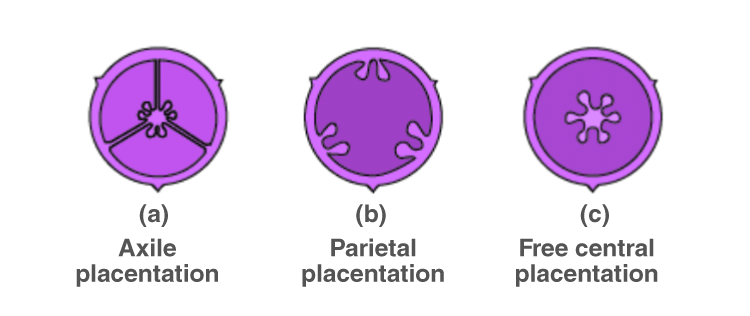
- Marginal: Ovules are attached to the margins of the ovary, seen in peas.
- Axile: Ovules are attached to the central axis of the ovary, seen in lemon and China rose.
- Parietal: Ovules are attached to the walls or partitions of the ovary, seen in Argemone and mustard.
- Free central: Ovules are attached to a central column within the ovary, seen in primrose and Dianthus.
- Basal: Ovules are attached to the base of the ovary, seen in marigold and sunflower.
The Fruit
A fruit is the matured and ripened ovary after fertilization has occurred. Parthenocarpic fruit: This type of fruit forms without fertilization, resulting in seedless fruits, as seen in pineapples. A fruit is composed of both seed and pericarp. The pericarp, which is the fleshy part of the fruit, consists of three layers: the epicarp, mesocarp, and endocarp.The Seed
Following fertilization, the ovule develops into a seed, comprising a seed coat and an embryo. In dicotyledonous seeds (such as peas and grams), the embryo consists of a radicle, embryonal axis, and one or two cotyledons, whereas in monocotyledonous seeds (like maize and wheat), there is a single large cotyledon known as the scutellum.| Characteristic | Dicotyledonous Seed | Monocotyledonous Seed |
|---|---|---|
| Seed Coat Composition | Consists of two layers: outer testa and inner tegmen | Composed of a fused, membranous seed coat |
| Attachment Scar | Presence of a scar known as hilum, where the seed was attached to the fruit | The hilum is accompanied by a micropyle above it |
| Embryo Composition | Contains an embryonal axis and two cotyledons | Comprises a single large cotyledon called scutellum |
| Food Storage | Cotyledons store food reserves | Endosperm is the primary food storage tissue |
| Endosperm Composition | Mostly non-endospermic, but exceptions like castor exist | Mostly endospermic, although exceptions like orchids are non-endospermic |
| Outermost Endosperm Layer | Aleurone layer separates the embryo from the endosperm | Absent in endospermic seeds, where the endosperm is bulky |
| Embryonal Axis Structure | Radicle and plumule present at the two ends | Plumule enclosed in coleoptile; radicle enclosed in coleorhiza |
Benefits of CBSE Class 11 Morphology of Flowering Plants
- The notes provide a detailed overview of the morphology of flowering plants, covering various aspects such as roots, stems, leaves, flowers, and fruits.
- The content is presented in a clear and concise manner, making it easy for students to understand complex botanical concepts.
- The notes follow a structured format, organizing information in a systematic manner, which aids in better comprehension and retention.
- These notes are beneficial for exam preparation, helping students revise important topics efficiently and effectively.
- Where applicable, diagrams, illustrations, and tables are included to visually represent key concepts, facilitating better understanding and retention.
CBSE Class 11 Biology Notes Chapter 5 FAQs
How can these notes help in understanding the morphology of flowering plants?
What are some common misconceptions about plant morphology?
Are there any practical applications of studying plant morphology?


